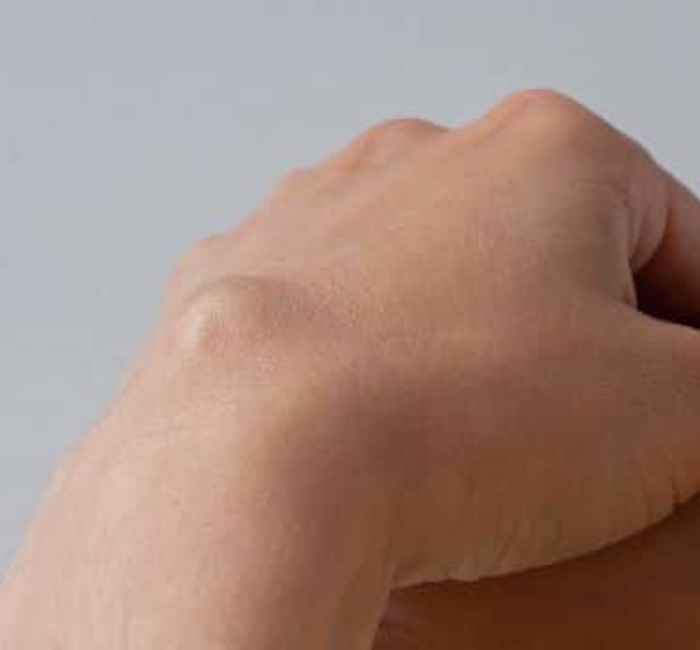Procedures
Ganglion Removal Surgery

A ganglion cyst can be a source of discomfort or worry for many people. This lump, often found on the hand or wrist, might seem puzzling or unsettling. You’re not alone if you’ve noticed one on your body. Fortunately, there’s a solution at hand, termed as ‘Ganglion Removal Surgery’.
A ganglion cyst, though usually benign, can bring unwanted pain or inconvenience. It forms when fluid leaks from a joint or tendon, pooling and solidifying into a non-cancerous lump. These cysts can grow or shrink over time, and while some may disappear entirely on their own, others persist, causing discomfort or limiting movement. That’s where Ganglion Removal comes into the picture.
Chester Consultant Plastic Surgeon Anca Breahna performs ganglion removal surgery, as well as other face, body and skin procedures.
At a glance
Less than an hour
Local or General Anaesthesia
Table of Contents
What is Ganglion Removal Surgery?
Ganglion Removal is a surgical process designed to treat ganglion cysts. The main aim of the is to remove the cyst and alleviate any associated symptoms.
In some cases, a cyst may reduce in size or disappear entirely without treatment. However, when it causes pain, limits mobility, or is a cause of concern due to its appearance, Ganglion removal might be considered. The operation aims to excise the cyst and the part of the tendon sheath or joint capsule (the root) from where it originated.
This procedure is generally regarded as safe and effective, with the ultimate goal being the complete and permanent removal of the cyst, thus relieving the patient of discomfort and improving the range of motion.

Who Needs Ganglion Removal?
While a ganglion cyst is generally harmless, certain individuals might benefit more from a Ganglion removal. Here are a few pointers to help identify if you might be a suitable candidate for this surgery:
- Pain or discomfort: The most common reason to consider this procedure is if the cyst is causing you significant pain or discomfort. This might be a constant dull ache or sharp pains when using the affected joint
- Limitation of movement: If the cyst is located in such a way that it restricts movement of a joint or tendon, this can impact your daily life. The procedure can help restore your range of motion
- Aesthetic concerns: Although less common, some people choose to have a ganglion cyst removed due to dissatisfaction with its appearance
- Failure of non-surgical treatments: If other methods of treatment, such as aspiration or using a splint or brace, have failed to provide relief, surgery may be considered
Remember, the decision to undergo surgery should always be made in consultation with a plastic surgeon, taking into account your personal circumstances and health history.
Benefits of the Ganglion Removal Procedure
There are several advantages to undergoing a Ganglion removal procedure. Here are a few to consider:
- Pain Relief: The primary benefit of the procedure is the relief from discomfort. If the cyst has been causing pain, having it removed should alleviate this
- Improved mobility: If the cyst has been limiting the use of a joint or tendon, surgery can restore your range of motion
- Permanent Solution: While some cysts can disappear on their own or through non-surgical treatment, these methods don’t guarantee that the cyst won’t return. In contrast, surgical removal of the cyst and its root can offer a permanent solution
- Aesthetic Improvement: For those who are dissatisfied with the appearance of the cyst, having it surgically removed can result in aesthetic improvement
While these benefits may be appealing, it’s always important to discuss the risks and potential complications with Anca before making a decision.
Types of Ganglion Removal Procedures
Open Surgery
- Procedure: A larger incision is made over the cyst, allowing your plastic surgeon full view of the cyst and the surrounding area
- Removal: The cyst and part of the joint capsule or tendon sheath (the root) are removed entirely
- Recovery: Open surgery may require a slightly longer recovery period as compared to other methods
- Effectiveness: This method is generally considered to be more definitive in treating the ganglion cyst
Arthroscopic Surgery
- Procedure: A smaller incision is made, and a tiny camera (arthroscope) is inserted to guide your plastic surgeon in removing the cyst
- Removal: The cyst is removed in a similar fashion to open surgery but through a smaller incision
- Recovery: Typically, arthroscopic surgery has a faster recovery time
- Effectiveness: This method can be as effective as open surgery but may be preferred for cysts in certain locations
How Is the Ganglion Removal Procedure Performed?
Here’s a general outline of how the Ganglion removal procedure is usually performed:
- Consultation and Evaluation: Initially, a thorough examination and sometimes imaging tests (like an X-ray or MRI) are conducted to understand the cyst’s size, location, and connection to nearby structures
- Anaesthesia: Depending on the type of surgery and the patient’s preferences, local or general anaesthesia may be administered to ensure comfort during the procedure
- Incision: A cut is made over the cyst. In open surgery, this will be larger, while in arthroscopic surgery, it will be smaller
- Removal of the Cyst: Your plastic surgeon will carefully dissect the cyst and its root from the surrounding tissues, ensuring that all parts are removed to minimise the chance of recurrence
- Closure: The incision will be stitched up, and a bandage applied
- Post-operative Care: Specific instructions will be provided for care at home, including pain management, wound care, and activity restrictions
The entire procedure usually takes less than an hour and can often be performed as an outpatient surgery, meaning you can go home the same day.
Recovery after Ganglion Removal Procedure
Recovering from a Ganglion removal procedure involves several stages and factors that contribute to a successful healing process. Let’s explore them in detail:
Immediate Post-Operative Period
- Right after surgery, it’s normal to experience some pain and swelling at the site of operation
- Anca will likely prescribe painkillers to help manage any discomfort
- Elevating the affected area and applying a cold pack can also help reduce swelling
Wound Care
- After the procedure, it’s crucial to keep the surgical area clean and dry to prevent infection
- You should follow your plastic surgeon’s instructions for changing dressings, if needed
- You will need to avoid getting the area wet until it has sufficiently healed, usually a few days after the operation
Activity Restrictions
- During the initial recovery period, you will likely need to limit movement of the affected area
- Using a sling or splint can help protect the surgery site and limit movement, particularly for wrist or hand cysts
- You should avoid heavy lifting or strenuous activities until your plastic surgeon gives you the go-ahead
Physical Therapy and Exercise
- Gentle exercises or physiotherapy may be recommended to help restore strength and mobility in the affected area
- This usually starts with simple movement exercises and progresses to strengthening exercises as healing continues
Follow-up Appointments
- Regular check-ups are part of the recovery process
- During these visits, Anca will check the healing progress, remove stitches if necessary, and address any concerns or complications
- This is also when you can discuss returning to normal activities or work
Long-Term Recovery
- Most people make a full recovery within a few weeks to a couple of months
- During this time, you should notice gradual improvement in pain, swelling, and mobility
- It’s essential to continue following your plastic surgeon’s advice, even as symptoms improve, to ensure optimal healing and prevent complications
Reviews
Patient satisfaction is the top priority for Anca. You can find how patients feel about her work below.
Wish I’d Done It Sooner! I am so pleased with the results
After searching and deliberating for a long time, I consulted Anca regarding the removal of 3 lipomas. From start to finish, she was fantastic! One of the lipomas was on my forehead and I have to search for the scar! I am so pleased with the results of all and the one regret is that I didn’t find her sooner. I wouldn’t hesitate to recommend her

Miss Breahna removed a cancerous nodule from my forehead in March 2021. I was quite nervous when I arrived at the hospital, but when I was greeted by a member of her team I started to feel calmer as they were so professional and friendly.
Once inside the theatre Miss Breahna and her team helped me to feel relaxed and comfortable throughout, the team atmosphere was friendly and upbeat during my operation and I was looked after wonderfully. I would recommend Miss Breahna and her team to anyone requiring this type of surgery.
Kate Hodson

Ms Anca Breahna was most kind and empathetic during my recent procedure for skin cancer. She reassured me that I’m now completely clear, I have total confidence in her and would recommend her unreservedly. Thank you Anca.
Further Reading
- Read Anca’s Blog on Recovery after Cyst Removal
- Read Anca’s Blog on Why You Should See a Plastic Surgeon for Minor Skin Surgery, Lumps and Bumps

Procedure
Frequently asked questions
Is Ganglion removal a major surgery?
No, Ganglion removal is considered a minor surgical procedure. It’s usually performed on an outpatient basis, meaning you can go home the same day. The procedure is commonly performed under local anaesthesia, although general anaesthesia can be used if necessary.
How successful is the Ganglion removal procedure?
The success rate of Ganglion removal is quite high, with many patients experiencing complete resolution of symptoms. There is a chance of recurrence, particularly if the root of the cyst isn’t fully removed. It’s estimated that recurrence happens in about 10-15% of cases following surgical removal.
Will the surgery leave a scar?
Both open and arthroscopic procedures will leave a scar; however, the scar from an arthroscopic procedure is usually smaller and less noticeable. Over time, with proper care, these scars often fade significantly.
Can a ganglion cyst return after surgery?
While the goal of Ganglion removal is to permanently remove the cyst, there’s a small chance it can return. Recurrence is less likely following surgical removal compared to less invasive treatments.
How long before I can return to normal activities post-surgery?
The recovery period can vary based on the individual, the type of surgery, and the location of the cyst. However, most people can return to their regular activities within a few weeks to a couple of months post-surgery. Your plastic surgeon will provide you with a more precise timeline based on your specific circumstances.
What are the Risks of Ganglion Removal Surgery
Like any surgical procedure, Ganglion removal has associated risks and potential complications. While these are rare, it’s essential to be aware of them:
- Infection: There is a risk of infection at the surgical site, which might require antibiotics or further treatment
- Nerve Damage: In some instances, nerves near the cyst might be damaged during surgery, leading to weakness or numbness
- Recurrence: Though unlikely, the cyst can sometimes recur, especially if the root is not entirely removed
- Stiffness: Temporary stiffness in the affected joint may occur, usually improving with time and physical therapy
- Scarring: Scarring at the incision site is possible, though minimal, especially with arthroscopic surgery
- Reaction to Anaesthesia: Some individuals may have an adverse reaction to anaesthesia, though this is rare
Discussing these risks with your plastic surgeon, understanding your unique situation, and following post-operative care instructions closely can help minimise potential complications.
Ganglion removal is a highly effective procedure that can provide relief from the discomfort and limitations caused by a ganglion cyst.
Medical References about Ganglion Removal
- Ganglion Cyst: Symptoms, Causes, Diagnosis – WebMD
- Excision of Ganglion Cysts – Oxford Academic
- Ganglion Cysts – Cleveland Clinic
- Ganglion Cyst – Mayo Clinic
- Ganglion Cyst – NCBI






